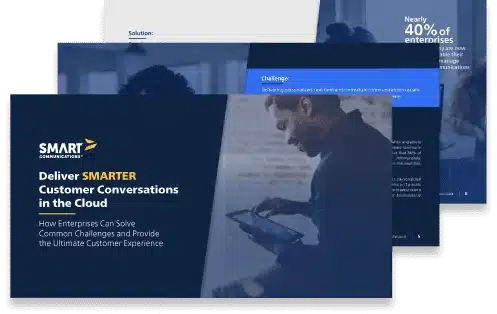Onboarding for Credit Card Customers: When Does It End?
By Scott Draeger, SVP of Product Marketing and Vertical Solutions at Smart Communications
While the title of this article might seem like an easy question to answer, it depends on who you ask. Whether it’s Marketing, Sales, Operations, Security, Compliance, Customer Experience, or Accounting, they’ll all have different answers. More importantly, your customers may have different opinions as well.
Let’s look at each of these perspectives to see why 45% of Banks say ‘digital account opening’ is a top investment priority, according Celent’s report, Retail Banking IT Priorities and Strategy in 2023 Leading banks are implementing cloud-native Customer Communication Management (CCM) technology to foster collaboration, attract new prospects, convert them to customers, and support important first transactions.
Marketing Stops Measuring When an Application is Started
The key metrics for a bank’s marketing team are Customer Acquisition Cost (CAC,) and other campaign performance metrics that measure how the department locates prospects, engages them, and converts prospects into qualified opportunities. Banks also have a variety of Conversion Rates (CVR) that track prospects to leads, lead to loan applications, application to approval, and other key milestones in the customer lifecycle. When a marketing campaign works—whether it is a TV commercial, email, social ad, billboard, t-shirt cannon, or other channel—a prospect provides some information, and the prospect turns into a qualified sales lead.
Your marketing team has a rapidly growing technology stack that helps them collect, check, and correct the data before qualifying it as a lead. Once it qualifies as a valid lead, it is sent to the Customer Relationship Management (CRM) system. Once it’s an opportunity, the marketing team returns their focus back to attracting more prospective customers. A poorly designed application experience will result in marketing hitting their targets, but lower conversions across the customer lifecycle.
Sales Stops Measuring When a Customer is Approved
The sales team and marketing may squabble from time to time over the quality of the leads that come into the CRM system. When the leads are pursued, the sales team generally measures the conversion of the leads to accounts and the size of the accounts opened. Before a customer is approved, the sales team will rely on partners from operations and compliance before they can claim success.
Operations and Compliance Partner on Qualification and Fulfillment
Operations and compliance require tight IT integrations, as operations often hosts the IT aspects of the application experience. Whether this is entirely digital, via the telephone, in person, or a combination of methods, the operations team must collect data from the applicant, and then quickly turn it over to the security and compliance teams to ensure compliance with Anti Money Laundering (AML) and Know Your Customer (KYC) regulations while screening for fraud. If this integration is not smooth, time is lost. This lost time can be interpreted as inconvenience, incompetence, or disinterest. After the risk and compliance checks are passed on the data side, the operations team starts to process the new account.
Then, operations’ chain of processes begins. An account number is assigned, the card(s) are produced, the cards are mailed, a digital message includes delivery time and channel, and delivery confirmation messages are sent. Once the card is delivered, operations waits for an omnichannel activation. If activation is not timely, reminders may be sent to ensure the card was received by the customer.
Leaders Don’t Stop Measuring When the Card is Activated
Once the card is activated, surely, the onboarding journey is complete, or is it? The customer experience, or customer success teams, want to see that active card being swiped, tapped, and added to digital wallets, because no bank wants to incur the costs of marketing, application processing, fraud detection, risk management, physical production, and rush delivery just to be a backup account with zero activity. At leading firms, Customer Experience (CX) and customer journey experts work to arrange activity while the card is in transit. They issue interim digital numbers to facilitate the first usage, for example.
CX leaders often send instructions on how to connect the account to a digital wallet, smart watch, key internet retailers, or other default payment methods while the card is in transit. During this initial period, banks also work to help the customer set up their payment method to link to their bank account. When done well, customer experience teams can inspire a new customer to connect to funding sources, put the card as a default payment option for commonly used apps, and make the first transaction. Then, and only then, is a customer fully onboarded.
When Does the Customer Stop Measuring?
The customer never stops measuring because they don’t think about your departments at all. The less they must think about your organization, the better you are performing. But many organizations are siloed, which creates frustration for the individual who moves from campaign member to prospect to applicant to customer. They should not feel like they are being thrown over a wall from one department to another. But, if 45% of banks are investing in digital onboarding, that is a sign that the state of the art is not meeting customer expectations.
How Can I Ensure Onboarding Success at my Bank?
The common thread in all these departmental perspectives is communication with the future account holder. Customers expect rapid responses from financial institutions. Customers demand to know the status at any instance in the process. They want to know this from a variety of channels that they choose. Leading banks have moved away from a complicated combination of single-purpose departmental technology stacks. They are shifting to a unified Customer Communication Management (CCM) approach, to ensure the look, feel, tone, and delivery of communications that span the entire onboarding process are managed.
This approach allows a variety of stakeholders from sales, marketing, legal, risk, operations, compliance, and operations to work on relevant parts of communications, while collaborating as a group. CCM technology like SmartIQ™ facilitates the data collection, AML, KYC, and fraud prevention requirements during a seamless digital onboarding process.
Leading CCM technology, like SmartCOMM™, generates omnichannel communications that inform the customer at all the steps of the onboarding process.



